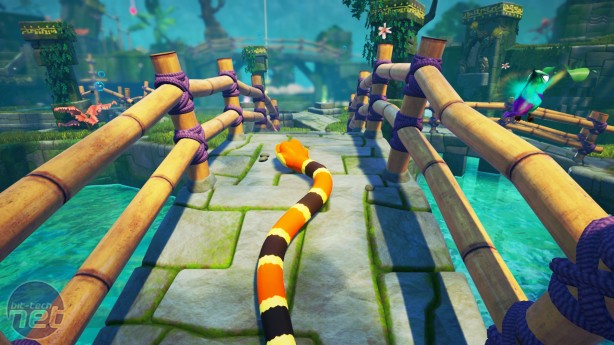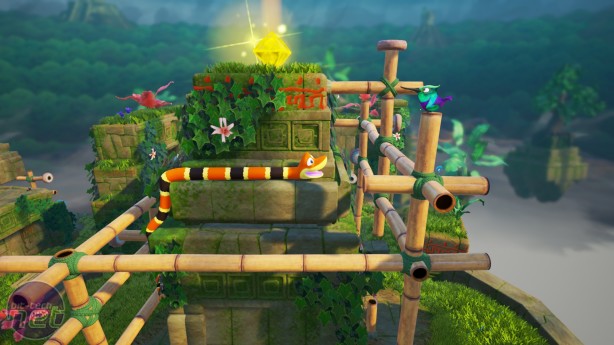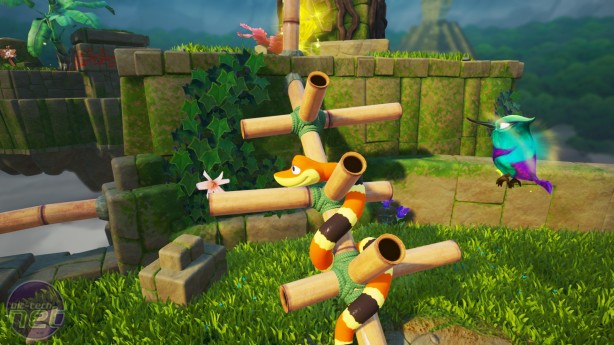
Perhaps even more amazing is how straightforward this is to control. Even using the keyboard and mouse, the complexities of the movement system are beautifully translated. That said, this is undoubtedly a game that benefits from the nuances of analogue sticks. There were times when raising my head caused Noodle to accidentally unwrap himself from a platform and plummet to the ground.
More generally, I love the bright and colourful aesthetic of Snake Pass, which brings to mind early 3D platformers like Crash Bandicoot and Banjo-Kazooie. Sumo Digital’s eye for detail is evident in the broader presentation too, from the chittering intensity of your companion Doodle, which stands in stark contrast to Noodle’s lackadaisical personality, to lovely little touches such as scuttling crabs that hide themselves as you approach. The soundtrack is jaunty and uplifting too, although a little too repetitive for my taste.
Sadly, this isn’t the only element of Snake Pass that’s repetitive either. The structure of the game is highly formatted. Each stage presents you with exactly the same objective: Collect three crystals to open the next portal. There are sub-categories of items to collect too, but there’s no reason to do so other than the challenge of getting to them. This was fine for the first couple of hours, but after that I was hoping Snake Pass would shake things up with a different style of challenge, but it never does.
There are some gradual changes. The game is divided up into four different stages, each with a slightly different theme. The second stage, for example, is a water-based environment with lots of underwater nooks and crannies you can swim through. Although the colour scheme is slightly different, these areas are fairly similar to those you experience in the first stage. The puzzles also gradually increase in difficulty, introducing bamboo platforms that rotate, rolling stones that you need to sweep across, and switches and levers which you have to wrap yourself around in order to activate. But none of this amounts to a significant evolution of the game’s systems. No new systems or concepts are introduced, and the story is too thin to carry you through the later stages.
There are also a couple of smaller issues I want to address. Snake Pass employs a checkpoint save system, which, like all checkpoint save systems, fails you horribly at some point. I became stuck on the second part of a three-stage puzzle for the best part of an hour and had to keep backtracking right to the beginning because I couldn’t save manually. I can accurately report this experience as “Headphone-snappingly infuriating”. Another irritating idiosyncrasy is that if you quit mid-stage, you can’t save your progress, which is not something you want to discover when a particular puzzle has you foaming at the mouth.
All these issues mean that Snake Pass is not the puzzle-platforming classic it could potentially be. It is, however, the most innovative platform game I have played in a long, long time. At just shy of sixteen sssssssssquids, I would recommend it for a few hours of slithery fun, even if it doesn’t quite make the best use of its length.
More generally, I love the bright and colourful aesthetic of Snake Pass, which brings to mind early 3D platformers like Crash Bandicoot and Banjo-Kazooie. Sumo Digital’s eye for detail is evident in the broader presentation too, from the chittering intensity of your companion Doodle, which stands in stark contrast to Noodle’s lackadaisical personality, to lovely little touches such as scuttling crabs that hide themselves as you approach. The soundtrack is jaunty and uplifting too, although a little too repetitive for my taste.
Sadly, this isn’t the only element of Snake Pass that’s repetitive either. The structure of the game is highly formatted. Each stage presents you with exactly the same objective: Collect three crystals to open the next portal. There are sub-categories of items to collect too, but there’s no reason to do so other than the challenge of getting to them. This was fine for the first couple of hours, but after that I was hoping Snake Pass would shake things up with a different style of challenge, but it never does.
There are some gradual changes. The game is divided up into four different stages, each with a slightly different theme. The second stage, for example, is a water-based environment with lots of underwater nooks and crannies you can swim through. Although the colour scheme is slightly different, these areas are fairly similar to those you experience in the first stage. The puzzles also gradually increase in difficulty, introducing bamboo platforms that rotate, rolling stones that you need to sweep across, and switches and levers which you have to wrap yourself around in order to activate. But none of this amounts to a significant evolution of the game’s systems. No new systems or concepts are introduced, and the story is too thin to carry you through the later stages.
There are also a couple of smaller issues I want to address. Snake Pass employs a checkpoint save system, which, like all checkpoint save systems, fails you horribly at some point. I became stuck on the second part of a three-stage puzzle for the best part of an hour and had to keep backtracking right to the beginning because I couldn’t save manually. I can accurately report this experience as “Headphone-snappingly infuriating”. Another irritating idiosyncrasy is that if you quit mid-stage, you can’t save your progress, which is not something you want to discover when a particular puzzle has you foaming at the mouth.
All these issues mean that Snake Pass is not the puzzle-platforming classic it could potentially be. It is, however, the most innovative platform game I have played in a long, long time. At just shy of sixteen sssssssssquids, I would recommend it for a few hours of slithery fun, even if it doesn’t quite make the best use of its length.


MSI MPG Velox 100R Chassis Review
October 14 2021 | 15:04












Want to comment? Please log in.